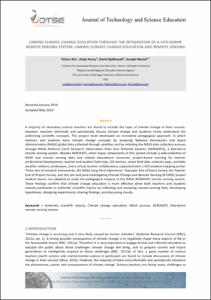Mostra el registre d'ítem simple
Linking climate change education through the integration of a kite-borne remote sensing system: linking climate change education and remote sensing
| dc.contributor.author | Xie, Yichun |
| dc.contributor.author | Henry, Paul A. |
| dc.contributor.author | Bydlowski, David |
| dc.contributor.author | Musial, Joseph L. |
| dc.date.accessioned | 2015-03-27T11:38:18Z |
| dc.date.available | 2015-03-27T11:38:18Z |
| dc.date.issued | 2014-09 |
| dc.identifier.citation | Xie, Yichun [et al.]. Linking climate change education through the integration of a kite-borne remote sensing system: linking climate change education and remote sensing. "JOTSE: Journal of Technology and Science Education", 2014, vol. 4, núm. 3, p. 120-137. |
| dc.identifier.issn | 2013-6374 |
| dc.identifier.issn | 2014-5349 |
| dc.identifier.uri | http://hdl.handle.net/2099/16269 |
| dc.description.abstract | A majority of secondary science teachers are found to include the topic of climate change in their courses. However, teachers informally and sporadically discuss climate change and students rarely understand the underlying scientific concepts. The project team developed an innovative pedagogical approach, in which teachers and students learn climate change concepts by analyzing National Aeronautics and Space Administration (NASA) global data collected through satellites and by imitating the NASA data collection process through NASA Airborne Earth Research Observation Kites And Tethered Systems (AEROKATS), a kite-borne remote sensing system. Besides AEROKATS, other major components of this system include a web-collection of NASA and remote sensing data and related educational resources, project-based learning for teacher professional development, teacher and student field trips, iOS devices, smart field data collector apps, portable weather stations, probeware, and a virtual teacher collaboratory supported with a GIS-enabled mapping portal. Three sets of research instruments, the NASA Long-Term Experience –Educator End of Event Survey, the Teacher End of Project Survey, and the pre-and-post-Investigating Climate Change and Remote Sensing (ICCARS) project student exams, are adapted to study the pedagogical impacts of the NASA AEROKATS remote sensing system. These findings confirm that climate change education is more effective when both teachers and students actively participate in authentic scientific inquiry by collecting and analyzing remote sensing data, developing hypotheses, designing experiments, sharing findings, and discussing results. |
| dc.format.extent | 18 p. |
| dc.language.iso | eng |
| dc.publisher | OmniaScience |
| dc.rights | Attribution-NonCommercial 3.0 Spain |
| dc.rights.uri | http://creativecommons.org/licenses/by-nc/3.0/es/ |
| dc.subject | Àrees temàtiques de la UPC::Ensenyament i aprenentatge::Ensenyament secundari |
| dc.subject | Àrees temàtiques de la UPC::Desenvolupament humà i sostenible::Degradació ambiental::Canvi climàtic |
| dc.subject.lcsh | Climatic changes |
| dc.subject.lcsh | Information science teachers |
| dc.subject.lcsh | Remote sensing |
| dc.subject.lcsh | Scientific inquiry--concepts, methods, and theories |
| dc.subject.other | Authentic scientific inquiry |
| dc.subject.other | Climate change education |
| dc.subject.other | NASA sources |
| dc.subject.other | AEROKATS |
| dc.subject.other | Kite-borne remote sensing system |
| dc.title | Linking climate change education through the integration of a kite-borne remote sensing system: linking climate change education and remote sensing |
| dc.type | Article |
| dc.subject.lemac | Canvis climàtics |
| dc.subject.lemac | Investigació científica -- Metodologia |
| dc.subject.lemac | Teledetecció -- Aparells i instruments |
| dc.identifier.doi | 10.3926/jotse.113 |
| dc.identifier.dl | B-2000-2012 |
| dc.description.peerreviewed | Peer Reviewed |
| dc.rights.access | Open Access |
| local.citation.author | Xie, Yichun; Henry, Paul A.; Bydlowski, David; Musial, Joseph L. |
| local.citation.publicationName | JOTSE: Journal of Technology and Science Education |
| local.citation.volume | 4 |
| local.citation.number | 3 |
| local.citation.startingPage | 120 |
| local.citation.endingPage | 137 |
Fitxers d'aquest items
Aquest ítem apareix a les col·leccions següents
-
2014, Vol. 4. núm. 3 [6]
Towards internationalization


